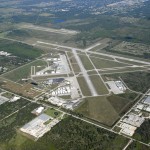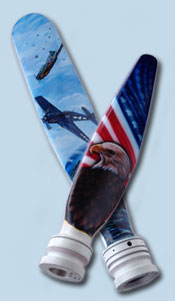AD 95-11-08
95-11-08
Amendment 39-9243. Docket 95-ANE-05.
Supersedes AD 73-02-01, Amendment 39-1584.
Applicability: Hartzell Propeller Inc. Models HC-92WK-( ) and HC-92ZK-( ) propellers, installed on but
not limited to the following aircraft: Aerostar Aircraft Corp. (formerly Ted Smith Aerostar) Model
Aerostar 360; Air & Space America, Inc. Model 18A; Aircraft Acquisition Corp. (formerly Helio)
Models H-250, 500; Beech Models 95, B95, B95A, D95A, E95; Cessna Models 172, 175, 175A;
Found Brothers Aviation Ltd. Models FBA 100, FBA-2C; Kwad Company Model Super-V; Mooney
Aircraft Corp. Model M20A; Piper Models PA-23, PA-24, PA-25; Procaer Model F15/B; Revo Inc.
Models C2, Lake LA-4; and Simmering Graz Pauker A.G. Model SGP-222.
NOTE 1: This airworthiness directive (AD) applies to each propeller identified in the preceding
applicability provision, regardless of whether it has been modified, altered, or repaired in
the area subject to the requirements of this AD. For propellers that have been modified,
altered, or repaired so that the performance of the requirements of this AD is affected,
the owner/operator must use the authority provided in paragraph (e) to request approval
from the Federal Aviation Administration (FAA). This approval may address either no
action, if the current configuration eliminates the unsafe condition, or different actions
necessary to address the unsafe condition described in this AD. Such a request should
include an assessment of the effect of the changed configuration on the unsafe condition
addressed by this AD. In no case does the presence of any modification, alteration,
or repair remove any propeller from the applicability of this AD.
NOTE 2: The above is not an exhaustive list of aircraft which may contain the affected Hartzell
Models HC-92WK-( ) and HC-92ZK-( ) propellers because of installation approvals
made by, for example, Supplemental Type Certificate or field approval under FAA Form
337 “Major Repair and Alteration.” It is the responsibility of the owner, operator, and
person returning the aircraft to service to determine if an aircraft has an affected propeller.
Compliance: Required as indicated, unless accomplished previously.
To prevent propeller blade separation, which could result in loss of control of the aircraft, accomplish
the following:
(a) For all affected propellers, within 10 hours time in service (TIS) after the effective date of this
AD, perform a blade clamp screw inspection in accordance with Procedure No. 1 of Hartzell
Propeller Inc. Service Bulletin (SB) No. 202, dated January 5, 1995. If any clamp screws are
loose (i.e., screws turn when applying torque in a clockwise rotation) or broken, remove
propeller and send to an authorized repair station for disassembly and inspection in accordance
with paragraph (b) of this AD prior to further flight.
(b) For affected propellers whose time since last blade dye penetrant inspection or compliance
with AD 73-02-01 is unknown, within the next 10 hours TIS after the effective date of this
AD, accomplish the following:
(1) Disassemble, perform a dye penetrant inspection of the blade shank, perform compressive
rolling of the blade shank, and replace clamp socket screws with Part
Number (P/N) A-321 clamp socket screws in accordance with Procedure No. 2 of
Hartzell Propeller Inc. SB No. 202, dated January 5, 1995. If cracks are found during
a dye penetrant inspection of the blade shank, replace with a serviceable blade that
has been compressively rolled in the blade shank.
(2) At intervals not to exceed 500 hours TIS since last inspection, repeat paragraph
(b)(1) of this AD. The P/N A-321 clamp screws are to be used one time only and are
to be replaced with new screws each time the propeller blade clamp is disassembled.
(c) For affected propellers whose time since last blade dye penetrant inspection or compliance
with AD 73-02-01 is greater than 275 hours TIS, within the next 25 hours TIS after the
effective date of this AD, accomplish paragraphs (b)(1) and (b)(2) of this AD.
(d) For affected propellers whose time since last blade dye penetrant inspection or compliance
with AD 73-02-01 is less than or equal to 275 hours TIS, prior to reaching 300 hours TIS
since last blade dye penetrant inspection or compliance with AD 73-02-01, accomplish
paragraphs (b)(1) and (b)(2) of this AD.
(e) An alternative method of compliance or adjustment of the compliance time that provides an
acceptable level of safety may be used if approved by the Manager, Chicago Aircraft Certification
Office. The request should be forwarded through an appropriate FAA Maintenance
Inspector, who may add comments and then send it to the Manager, Chicago Aircraft
Certification Office.
NOTE 3: Information concerning the existence of approved alternative methods of compliance
with this airworthiness directive, if any, may be obtained from the Chicago Aircraft
Certification Office.
(f) Special flight permits may be issued in accordance with sections 21.197 and 21.199 of the
Federal Aviation Regulations (14 CFR 21.197 and 21.199) to operate the aircraft to a location
where the requirements of this AD can be accomplished. Special flight permits should
not be issued if loose or broken screws are found.
(g) The actions required by this AD shall be done in accordance with the following Hartzell
Propeller Inc. SB:
Document No. Pages Date
SB No. 202 1-5 January 5, 1995
Total pages: 5.
This incorporation by reference was approved by the Director of the Federal Register in accordance
with 5 U.S.C. 552(a) and 1 CFR part 51. Copies may be obtained from Hartzell Propeller Inc., One
Propeller Place, Piqua, OH 45356-2634; telephone (513) 778-4200, fax (513) 778-4391. Copies
may be inspected at the FAA, New England Region, Office of the Assistant Chief Counsel, 12 New
England Executive Park, Burlington, MA; or at the Office of the Federal Register, 800 North Capitol



Leave a Reply
You must be logged in to post a comment.